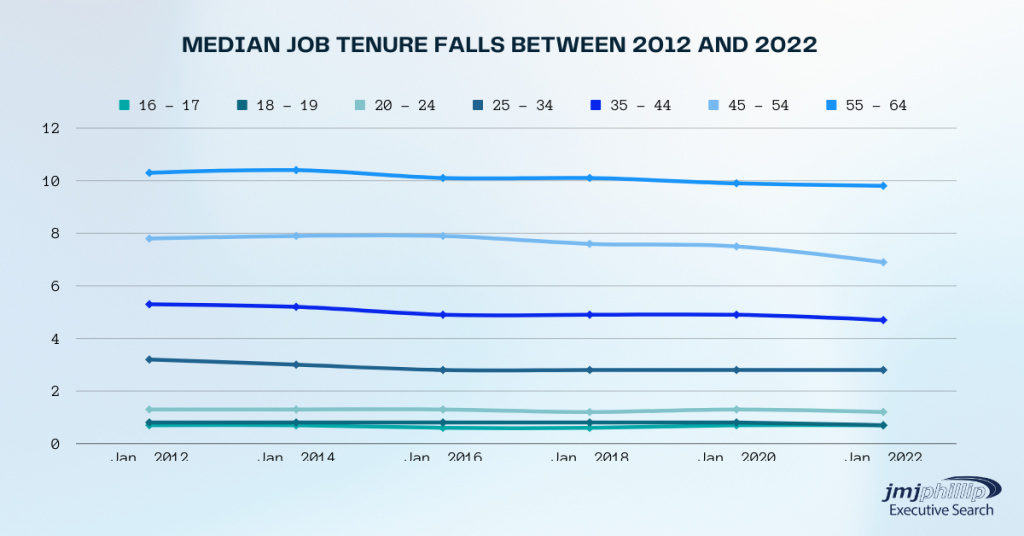
At JMJ Phillip Group, our firm has unmatched insights into workforce and labor market dynamics – especially as they relate to the manufacturing, supply chain, and technology sectors. If you have any hiring needs or have any questions regarding insights shared in these articles, I invite you to reach out to me at Dennis.theodorou@jmjphillip.com.
Building great workforces is challenge and once an organization finds the right individual to join them, employee retention then becomes a critical factor in organizational success. As we all know, tenure – especially among more mature workers – has been falling for years. As such, businesses are constantly seeking ways to attract, engage, and retain top talent, but a persistent challenge arises from a phenomenon known as “candidate bounce.” This term, borrowed from digital marketing, refers to the situation where new employees leave their positions prematurely, often due to unmet expectations.
The Root Causes of Candidate Bounce
The reasons for employee bounce are multifaceted, often stemming from a misalignment between an employee’s expectations and the realities of their work experience. This misalignment can occur in various aspects of the employment journey, from the initial hiring process to the ongoing work environment.
- Misrepresentation of the Job Role: During the recruitment phase, job descriptions and interviews often paint an idealized picture of the role, emphasizing the positive aspects and downplaying the challenges. However, the reality of the job may be far different, leaving new employees feeling deceived and disillusioned.
- Unrealistic Company Culture Expectations: Employees often form preconceived notions about a company’s culture based on their interactions with recruiters, company websites, and social media. If these perceptions don’t align with the actual work environment, employees may experience culture shock and feel dissatisfied.
- Oversold Growth Opportunities: New employees often join an organization with aspirations for professional development and career advancement. However, if this growth opportunity is oversold, employees realize that they have, in fact, not joined a high-growth company which can lead to bounce.
- Inadequate Onboarding and Training: A smooth and effective onboarding process is crucial for helping new employees acclimate to the company’s culture, understand their roles, and develop the skills needed to succeed. Poor onboarding can lead to frustration, confusion, and a lack of engagement, increasing the likelihood of leaving.
“The company culture piece is important when it comes to candidate bounce and we see it often with companies we work with,” says Kane Carpenter, Managing Director at Daggerfinn, a boutique employer branding and company culture consulting firm. “Too many companies have oversold their culture over the last few years, in an attempt to attract candidates in an increasingly-competitive hiring landscape, and the ramifications of this is not only candidate bounce but also a failing of culture internally. No one knows what the company’s value proposition is anymore because they live and breathe one thing, and all of their marketing speaks to a different reality.”
The Consequences of Employee Bounce
Employee bounce can have significant consequences for both employers and employees. For businesses, it can lead to:
- Increased Recruitment Costs: Replacing an employee, including the time and resources spent on recruiting, interviewing, and onboarding, can be costly.
- Reduced Productivity: The constant turnover of new employees disrupts workflow, slows down projects, and ultimately diminishes overall productivity.
- Damaged Brand Reputation: A high turnover rate can damage a company’s reputation, making it more difficult to attract and retain top talent in the future.
- Loss of Institutional Knowledge: As employees leave, they take with them their knowledge and experience, which can hinder the company’s ability to innovate and adapt.
For employees, the consequences of bounce include:
- Financial Setbacks: Severance packages may not compensate for the lost income and benefits associated with a new job search.
- Uncertainty and Anxiety: Navigating the job market can be stressful and time-consuming, leading to anxiety and uncertainty about the future.
- Lack of Professional Growth: Moving from job to job without staying long enough to gain meaningful experience can hinder career advancement and professional development.
Strategies to Mitigate Employee Bounce
To address the issue of employee bounce and foster long-term employee retention, organizations need to adopt proactive strategies to align expectations with reality. Here are some key measures to consider:
- Honest and Transparent Communication: From the initial recruitment stage, be open and honest with candidates about the job requirements, company culture, and growth opportunities. Avoid exaggerating or misleading language.
- Provide Realistic Job Previews: Enable candidates to experience the work environment and culture firsthand. Encourage shadowing current employees or offering virtual tours of the workplace.
- Invest in Employee Development: Create a comprehensive training and development program that supports employee growth and helps them reach their full potential. Offer opportunities for mentorship, skill-building, and cross-training.
- Foster a Supportive and Inclusive Work Environment: Promote open communication, collaboration, and mutual respect among employees. Ensure that everyone feels valued, appreciated, and heard.
- Regular Feedback and Recognition: Provide regular feedback to employees, both positive and constructive, to help them identify areas for improvement and recognize their accomplishments.
- Address Issues Promptly: When concerns or dissatisfaction arise, address them promptly and effectively. Create open channels for communication and encourage employees to bring forward their feedback.
- Recognize and Reward Loyalty: Appreciate long-serving employees with recognition, rewards, and opportunities for advancement. Foster a culture that rewards the right activities.
Candidate bounce is a costly issue for businesses, as it can lead to wasted time and resources spent on recruiting, onboarding, and training new employees. By taking steps to align expectations with reality, organizations can minimize candidate bounce and attract, retain, and develop top talent. By prioritizing transparency, honesty, and a positive work environment, businesses can create a workplace that attracts and motivates employees, ultimately contributing to their long-term success.